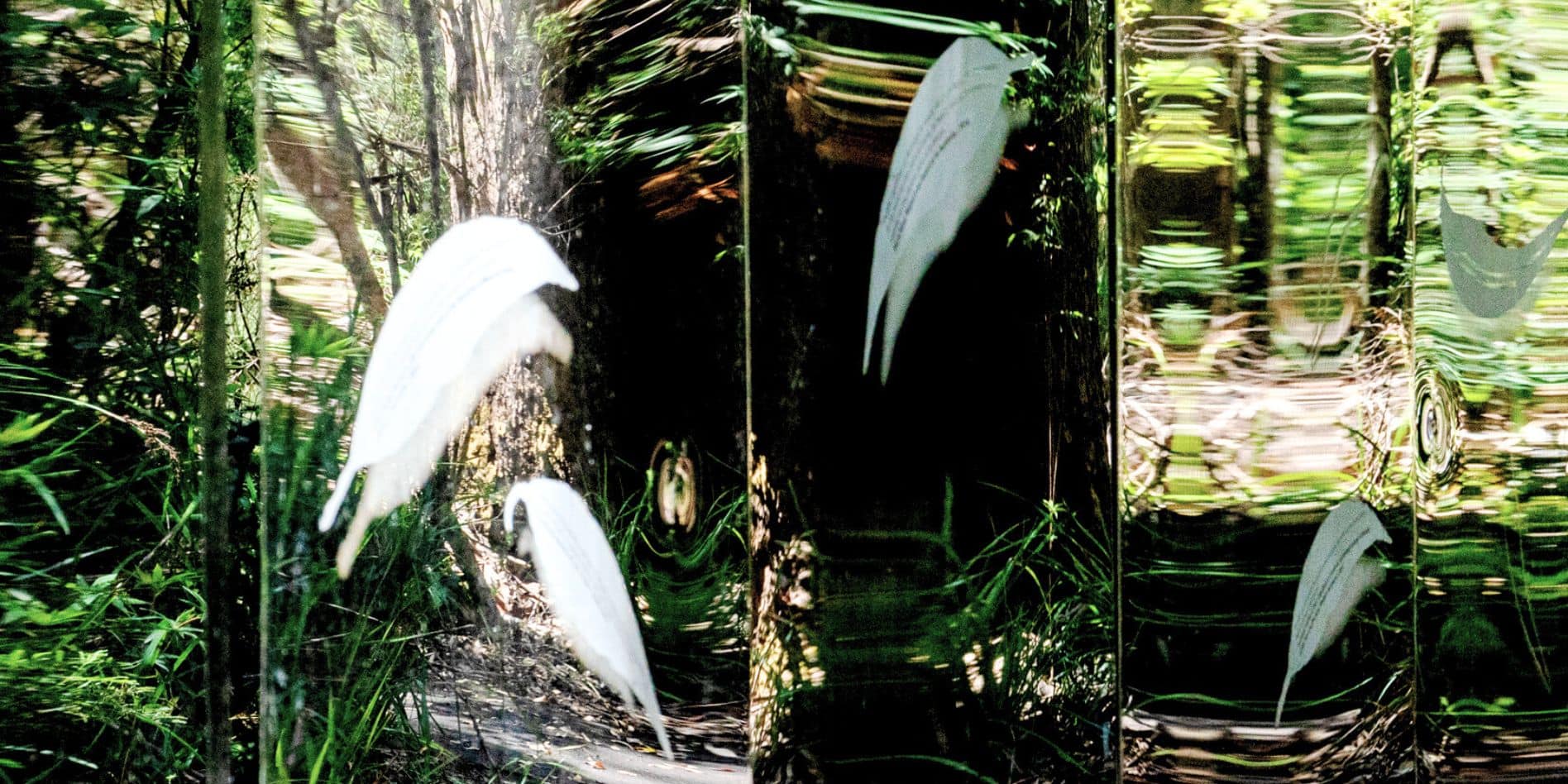The Swarbrick Art Loop is a captivating section of the Walpole Wilderness Discovery Centre, especially for those who cherish nature and its preservation. Various sculptures adorn the trail, each a call to contemplate our bond with the natural world and our impact upon it.
The stainless steel Wilderness Wall of Perceptions is at the heart of the Swarbrick Art Trail. It’s a mesmerising sight that invites reflection on our place in the world. Quotes are etched in leaf shapes on the wall, spanning a spectrum of views—from the appreciation of the forests and calls for preservation to attitudes of conquest.
I’m reminded of my family’s role in clearing these magnificent karri trees and the fine line between survival necessity and conservation.
My grandfather arrived from the UK at the age of 16 and worked for the early settlers in the southwest of Western Australia. One of his jobs was helping in the felling of these magnificent karri trees.
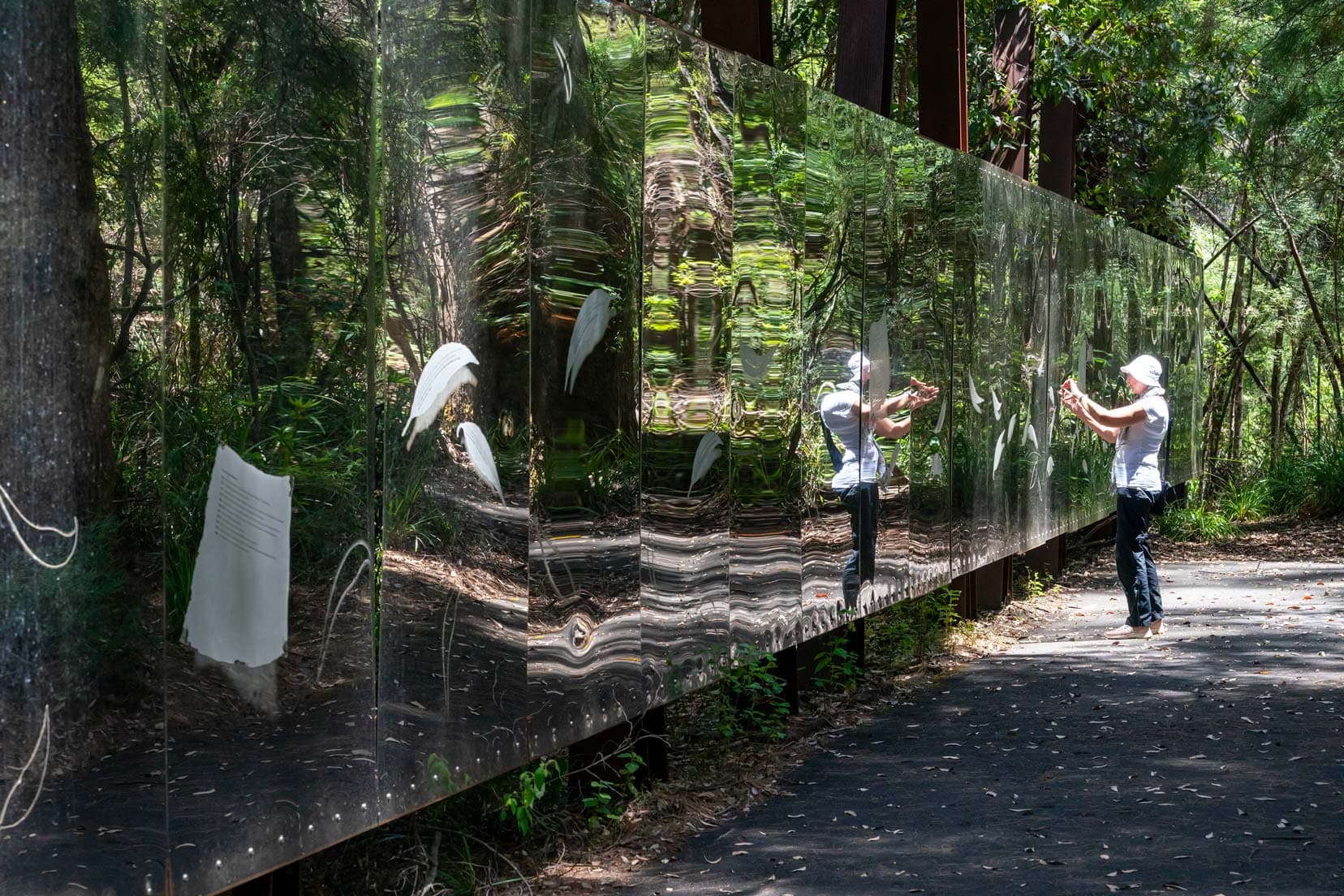
It’s almost unfathomable today to think that there was a time when the destruction of these majestic forests was considered necessary for survival and progress.
In saying that, though, there is still some opposition over the new laws that came into effect on the 1st of January 2024, making it illegal to log native hardwood in WA.
It is a difficult narrative when many locals’ lives still depend on the region’s timber industry.
Swarbrick Art Loop envelopes this history and invites us to engage in a vital conversation about our environmental footprint.
This is more than a walk through the woods; it’s an invitation to observe, listen, and ponder our role in the legacy of these splendid forests.
If you enjoy this type of thing, then add Northcliffe to your list of places to visit in the area. There, you’ll find Southern Forest’s Understory Art and Nature Trail, which is a gem you won’t want to miss.
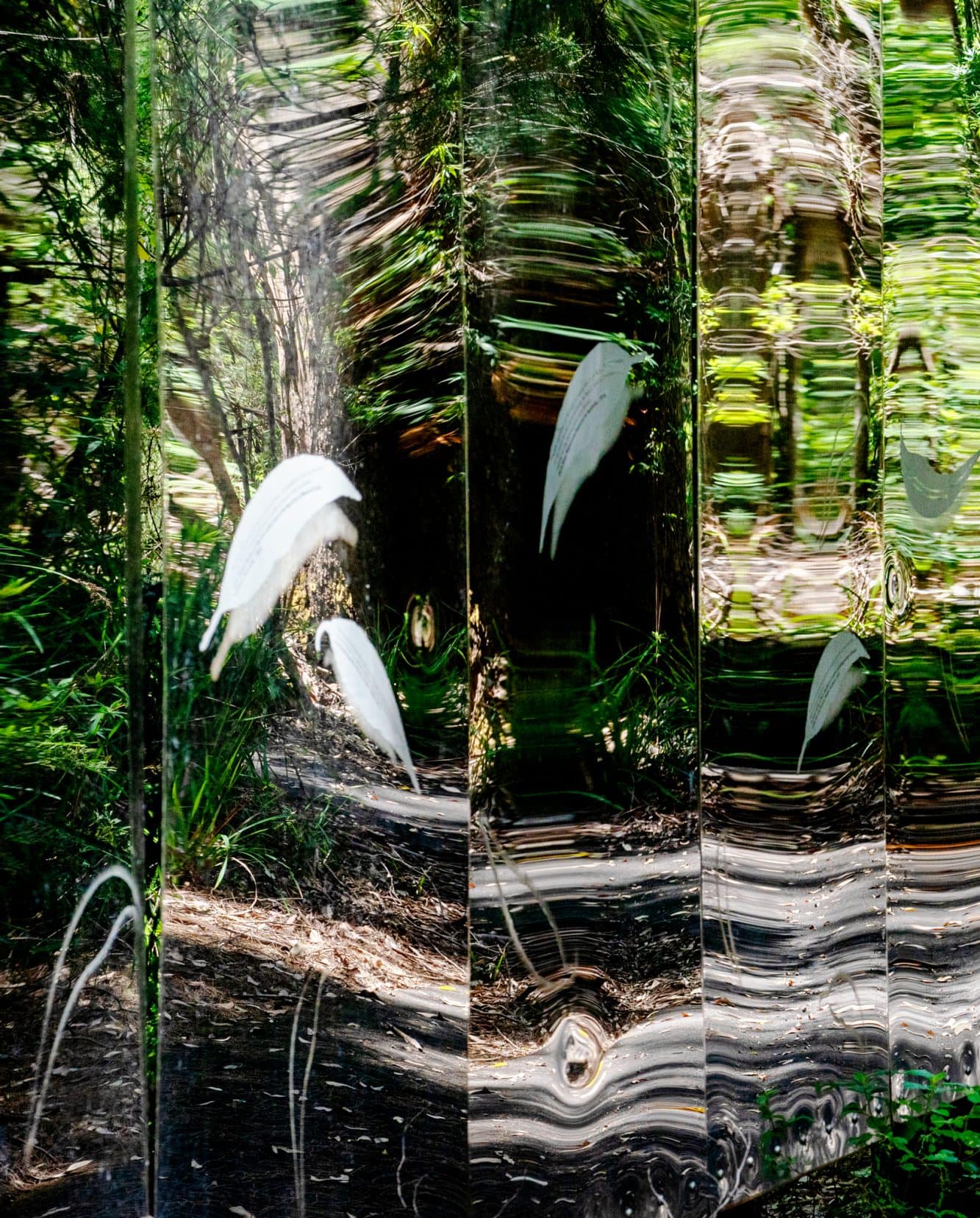
🍃 Swarbrick Art Loop Walpole: At a Glance
Here’s a quick overview of what you need to know to visit Swarbrick Art Trail:
- Art Sculptures: A selection of art pieces designed to challenge your perceptions.
- Distance: 500m short loop walk through old growth karri forest
- Difficulty: Class 2 (Easy walk)
- Time Required: Approximately 15 minutes
- Accessibility: Wheelchair accessible
- Location: 8km north of Walpole on North Walpole Rd
- Cost: Free entry
- Rules: No dogs allowed; adhere to ‘Leave No Trace’ principles to protect the environment
- Facilities: Parking and toilets
- Trail Highlights:
- Reflect on the Past: Begin your journey with the ‘Wilderness Wall of Perceptions, ‘ a stainless steel mirror that encourages reflection.
- Engage with the Art: Encounter each art piece as a dialogue on our relationship with nature.
- Embrace the Present: Immerse yourself in the tranquillity and beauty of the ancient Karri forest.
- Consider the Future: Ponder the evolution of conservation and our collective role in shaping a sustainable world.
This isn’t your normal art sculpture exhibition, and it’s a little quirky. But it’s not alone in being an unexpected attraction in WA.
If you are interested in the unusual art exhibitions, you will also enjoy the Understory Nature Art Trail in Northcliffe and the Tin Horse Highway in Kulin in the Wheatbelt.
To discover more places to visit in Western Australia, check out our dedicated page on Western Australia’s gems.
Swarbrick Walpole and Walpole Wilderness Map
The Journey Along the Swarbrick Art Loop
You start the Swarbrick Art Loop by passing the “Door of Perception”.
A welcome to the forest to “Discover the diversity of people’s relationship with this wild area through time.”
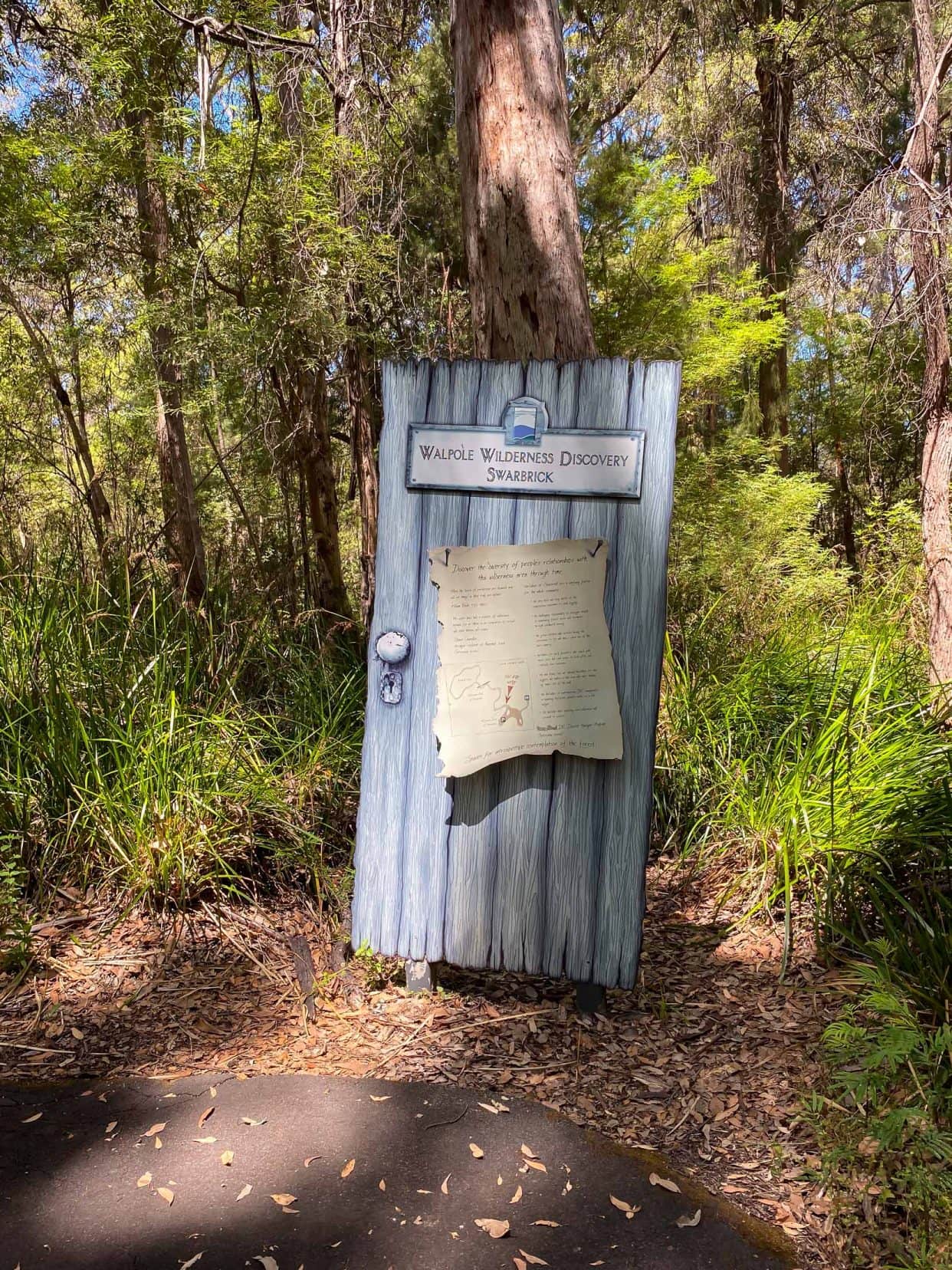
Reflecting on Change: The ‘Wilderness Wall of Perceptions’
Next, you’ll arrive at the Wilderness Wall of Perceptions, a reflective surface that demands a moment of pause.
If you pass by here too quickly, you overlook the very essence of the mirror’s purpose.
Read the quotes and learn about the thoughts around these great tingle and karri trees.
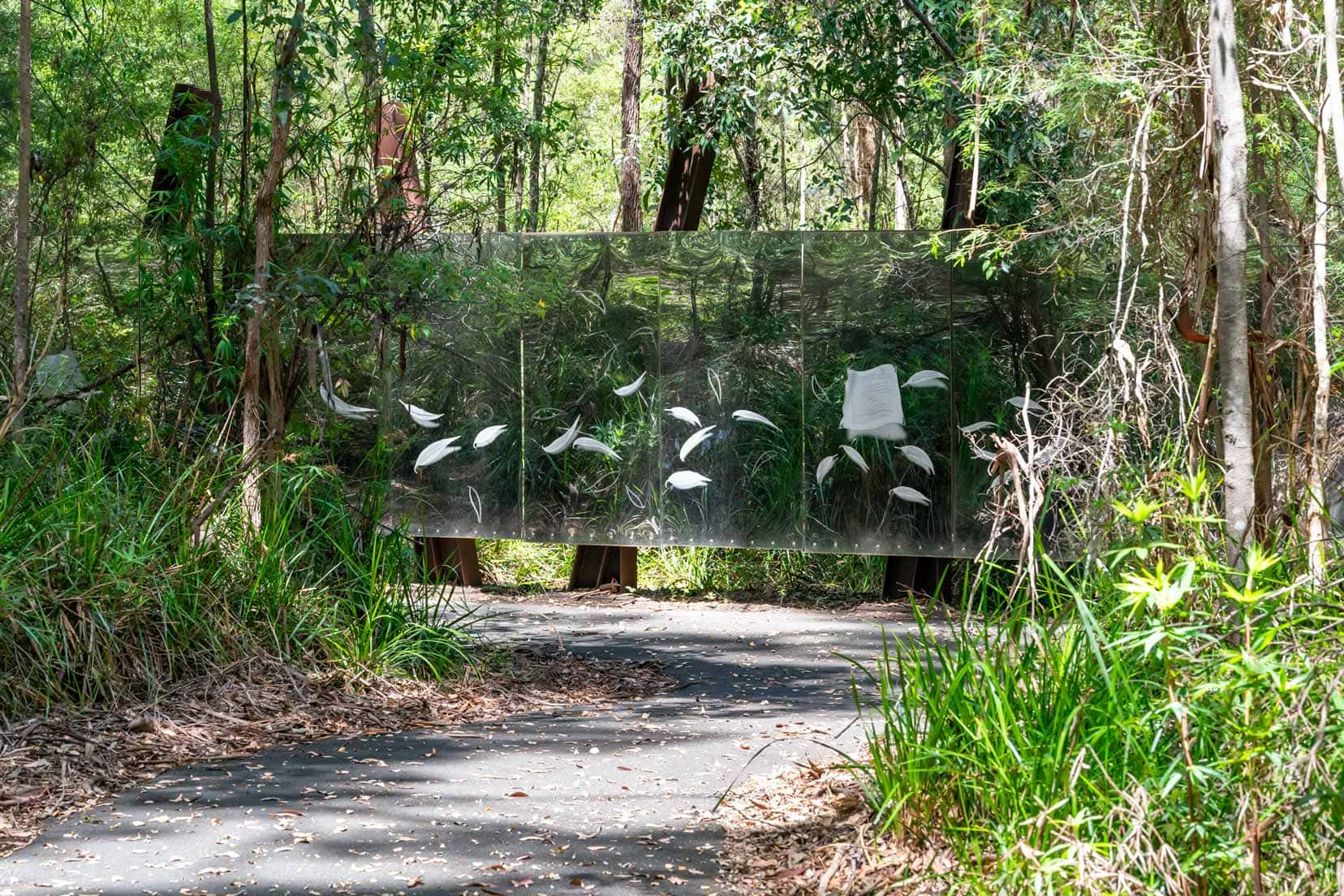
Ignoring these words overlooks the very essence of the mirror’s purpose.
This region, deeply rooted in the timber mill industry, faced a dilemma as the global opinion shifted towards climate change awareness and the imperative of protecting our natural environments.
The Impact of Early Settlers
The logging debate was never black and white in an area steeped in the livelihoods of early pioneers struggling to farm the land.
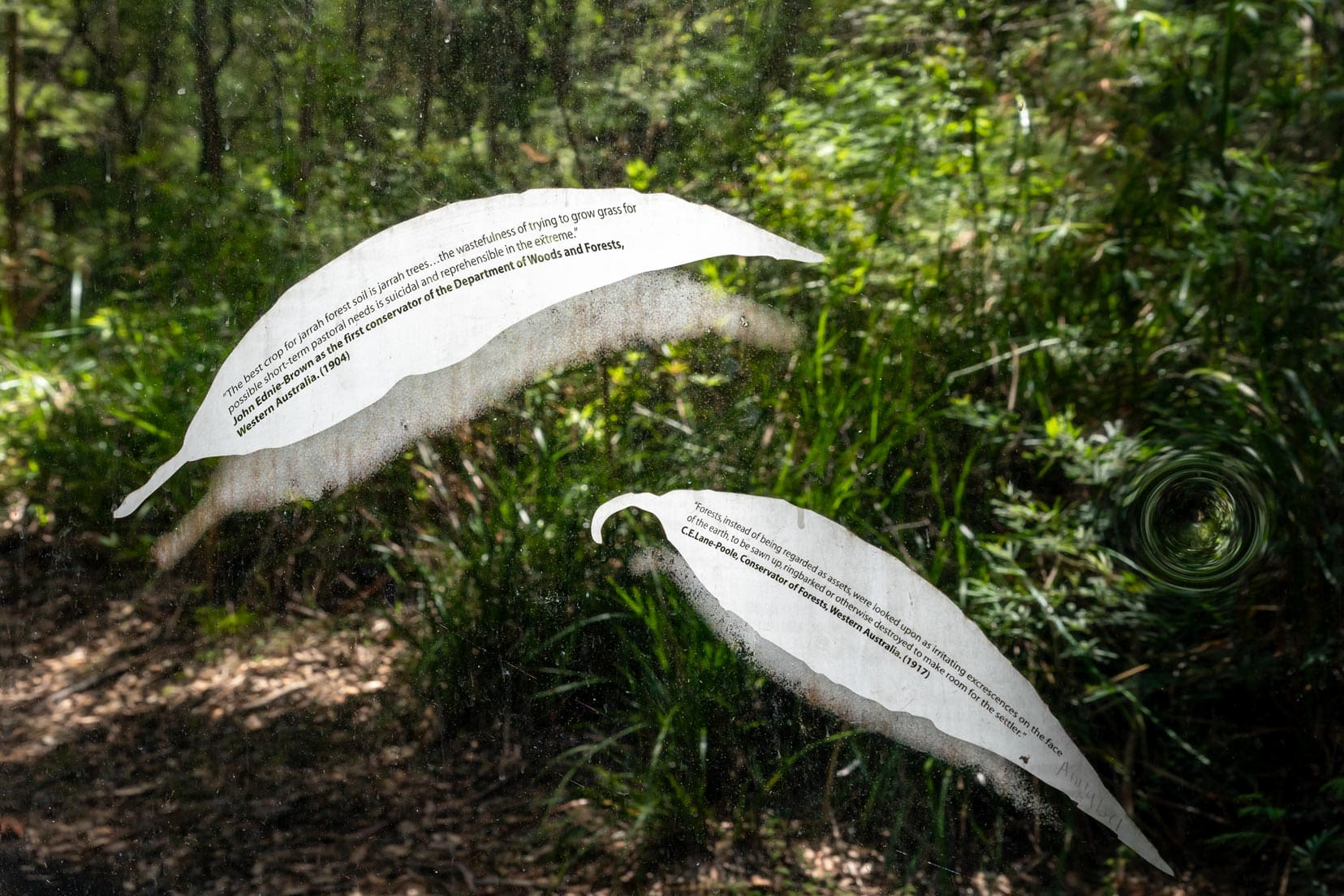
The best crop for jarrah forest soil is jarrah trees… the wastefulness of trying to grow grass for possible short-term pastoral needs is suicidal and reprehensible in the extreme.
John Ednie Brown – Conservator of the Department of Woods and Forests (1904)
Forests instead of being regarded as assets were looked upon as irritating excrescences on the face of the earth, to be sawn up, ring barked or otherwise destroyed to make room for the settler.
C.E Lane – Poole, Conservator of Forests Western Australia (1917)
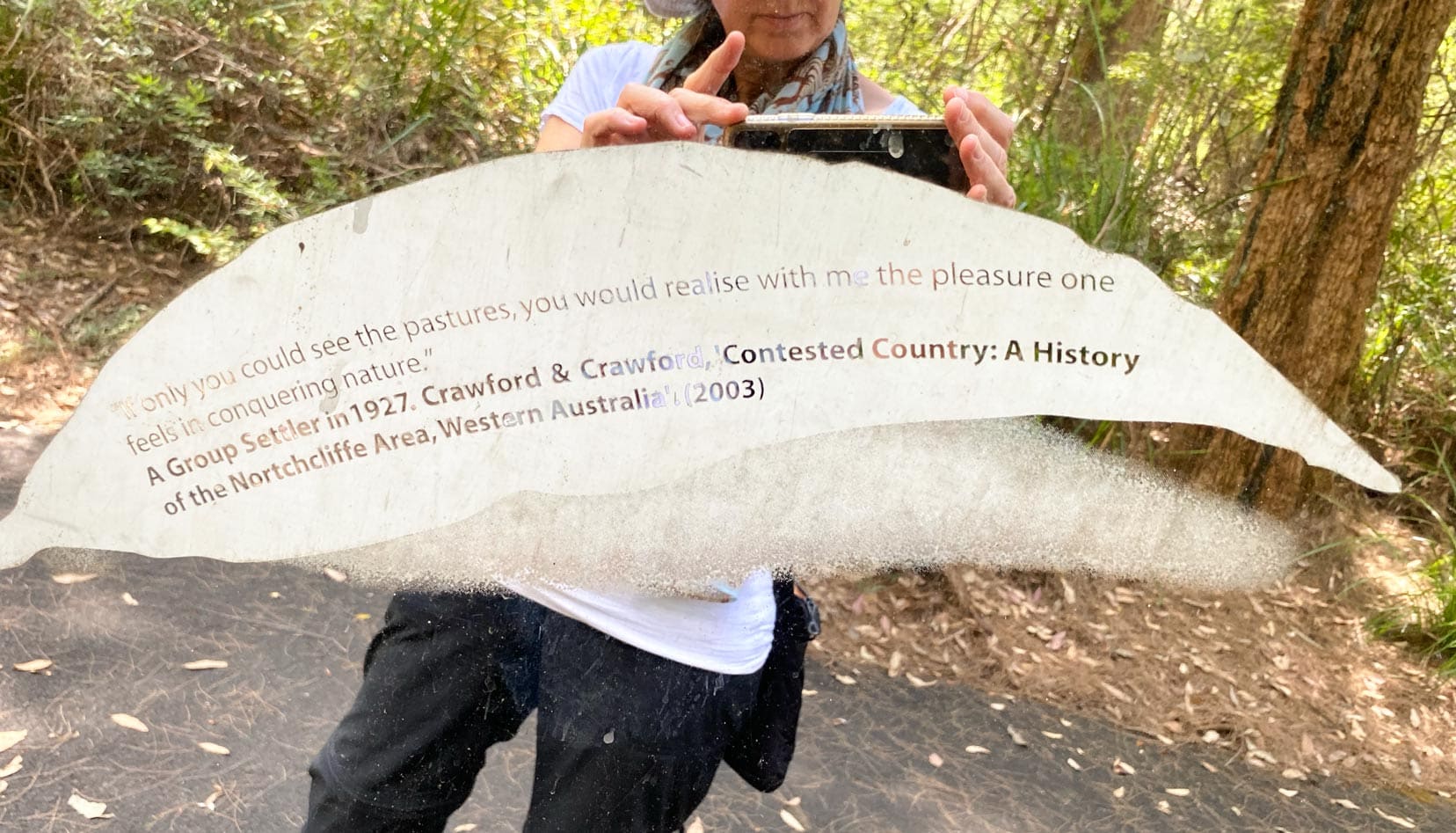
If only you could see the pastures, you would realise with me the pleasure one feels in conquering nature”
A group settler in 1927
A Personal Connection
I cannot help but be drawn to this above quote.
A year after this, in 1928, my grandfather first set foot on WA soil.
His letters to his parents tell of his journey from Fremantle, where he disembarked, to his first job in Forest Grove amongst the karri forests of the southwest.
The journey was very interesting being through thick forests nearly all the way. Forest Grove is in the height of the Karri Forest, right away from civilisation. The station is a shed by the track surrounded by forest and has no platform at the station.
…I am working for English people who have taken a block, cleared it of trees, and started a dairy farm. The country around here is very interesting, and I think I should like the life very much indeed.
Geoffrey Whittle, age 16 ,Nov 1928
He later had to change jobs and could only find work in the wheatbelt of Western Australia. In comparing his new place of work to that of the southern forests, he wrote:
I really did love that country; the thick shady forest ablaze with colour, the stately Karries and the sweet scent from the numerous flowering shrubs were lovely compared with these dry lifeless sandy stretches of shade less scrub.
Geoffrey Whittle, 1929
Even though he helped clear the trees, using gelignite and ring barking, he loved the bush.
And I’m sure he would be overjoyed to see these magnificent forests protected for future generations.
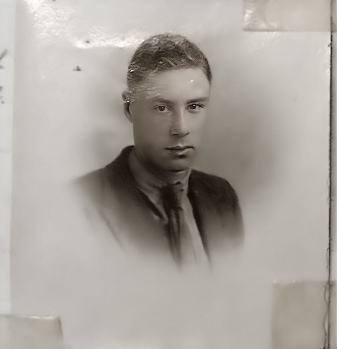
After two years of trying to make a go of it in Western Australia, he returned to the UK. But he visited several times when I came to live here. The last time was for his 90th birthday, and to that day, he deeply loved the Australian bush.
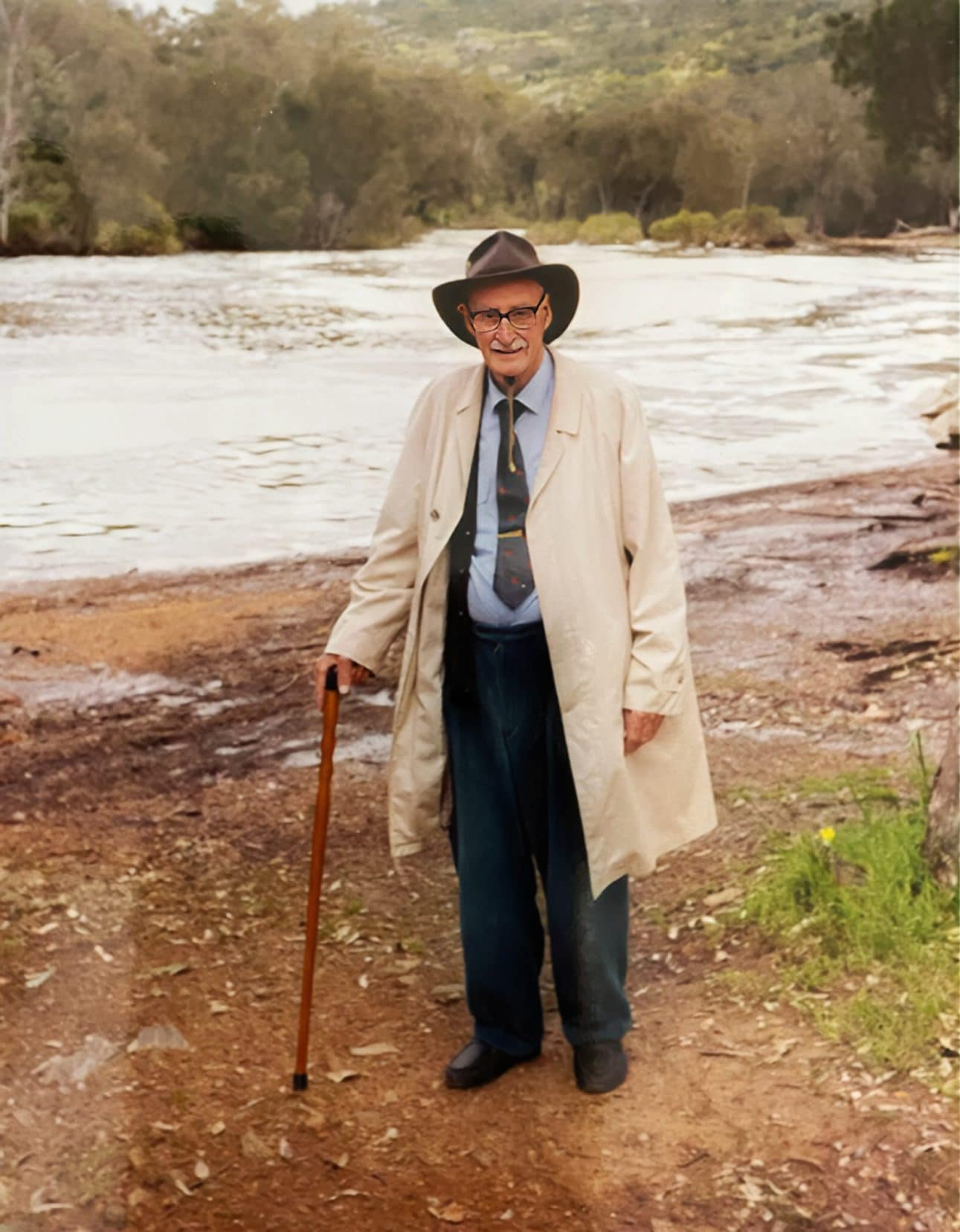
Support for the Forests
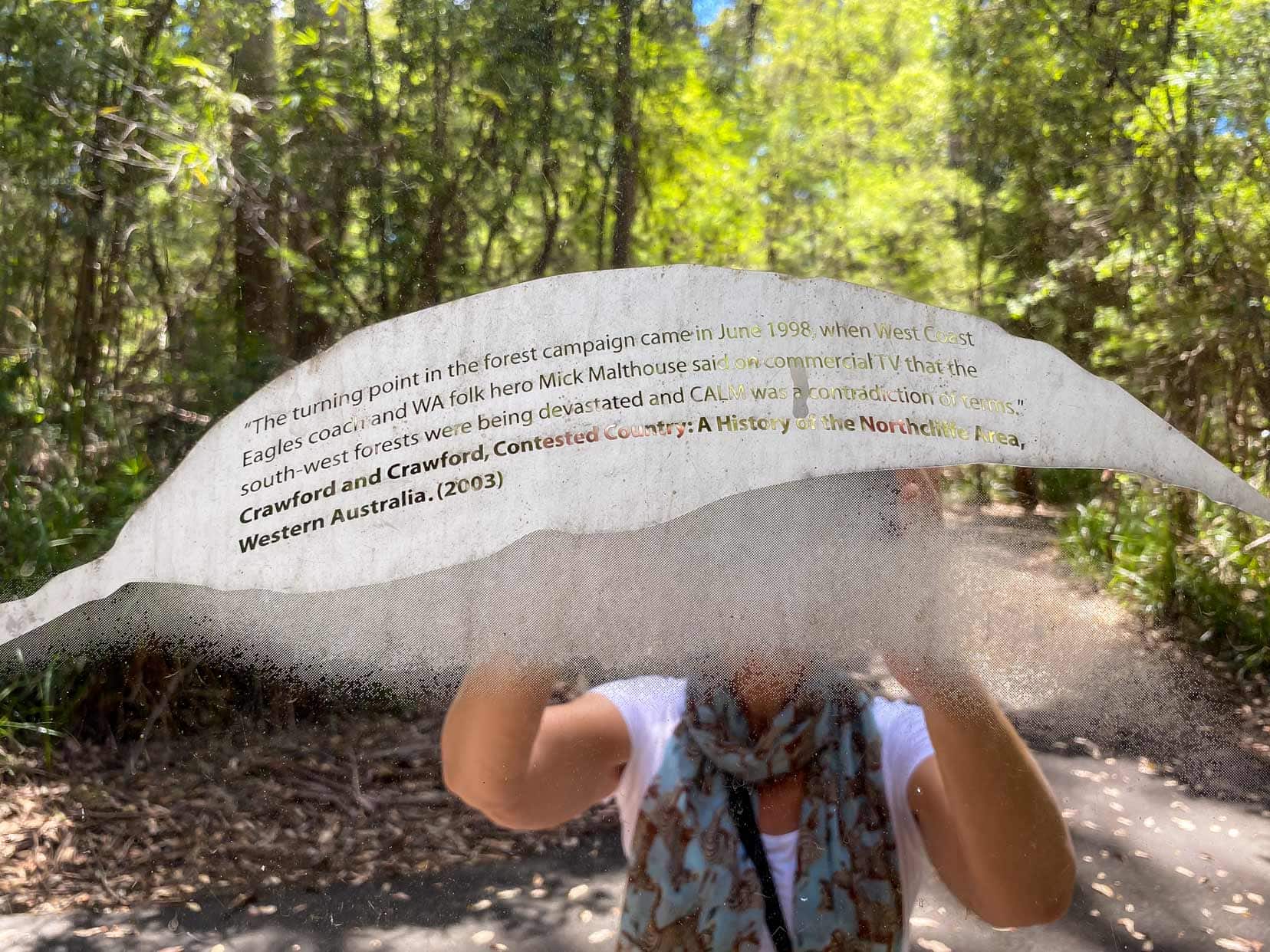
Today, as we grapple with the effects of climate change, the importance of protecting our forests and ecosystems has become a global concern, and society is much more aware of the need to protect our world.
The Swarbrick Art Loop embodies this shift, offering more than just art installations amidst the forest. It presents an open-hearted journey through the Walpole wilderness and an intimate look at the historical human struggles entwined with this ancient forest.
From the indigenous Noongar peoples to the colonial settlers and the local timber industry workers to the environmentalists, the Art Loop narrates the story of this land.

The Art Sculptures on the Trail
Each piece of art is a statement, an interaction between us and the forest, stirring emotions and prompting us to contemplate our bond with the planet and our collective responsibility to protect it.
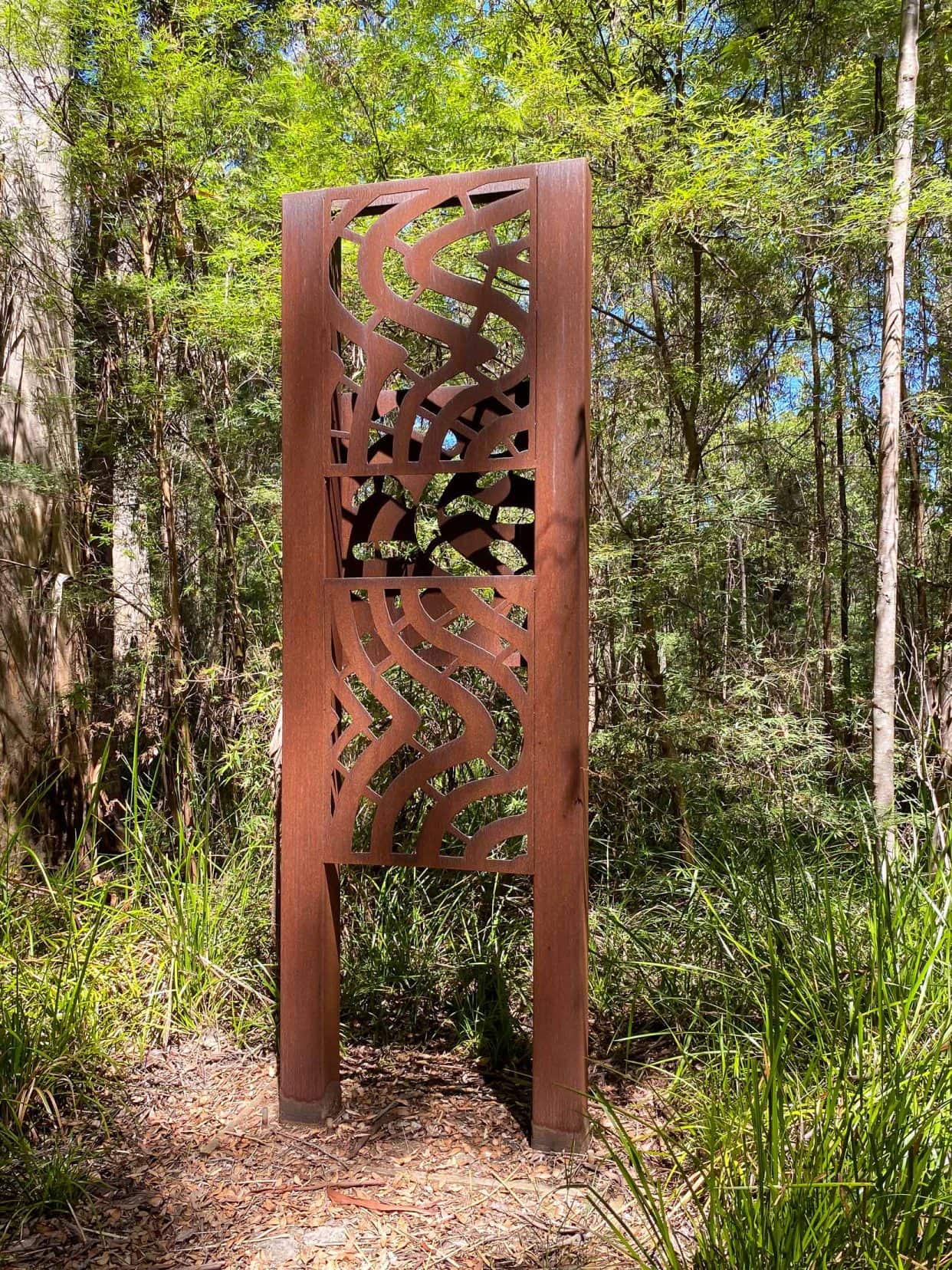
It evokes thoughts that in wilderness wild things roam.”
– Peter Farmer
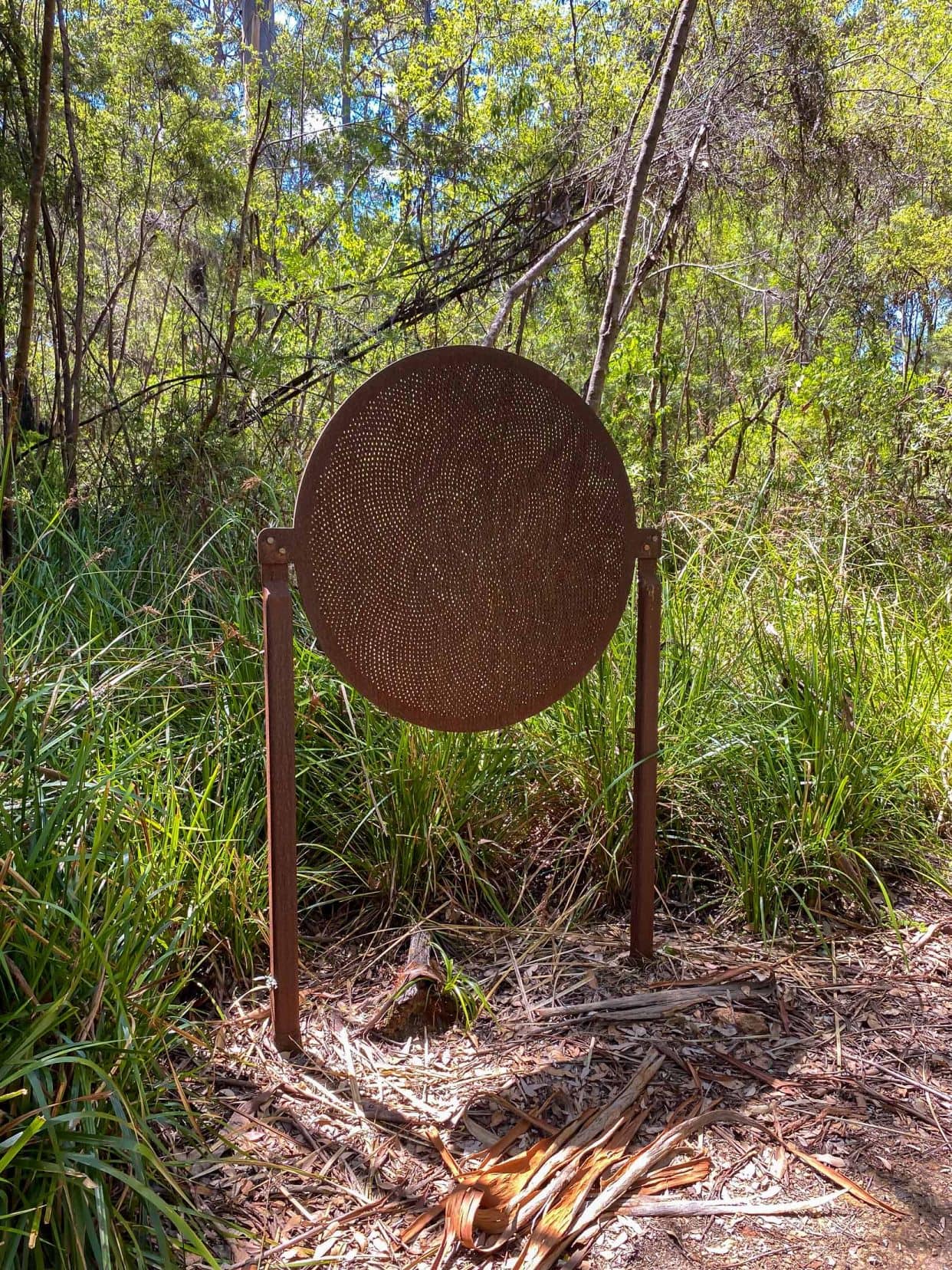
The view is flattened like an intrinsic mosaic of vibrating particles.”
Lorenna Grant & Alan Clark
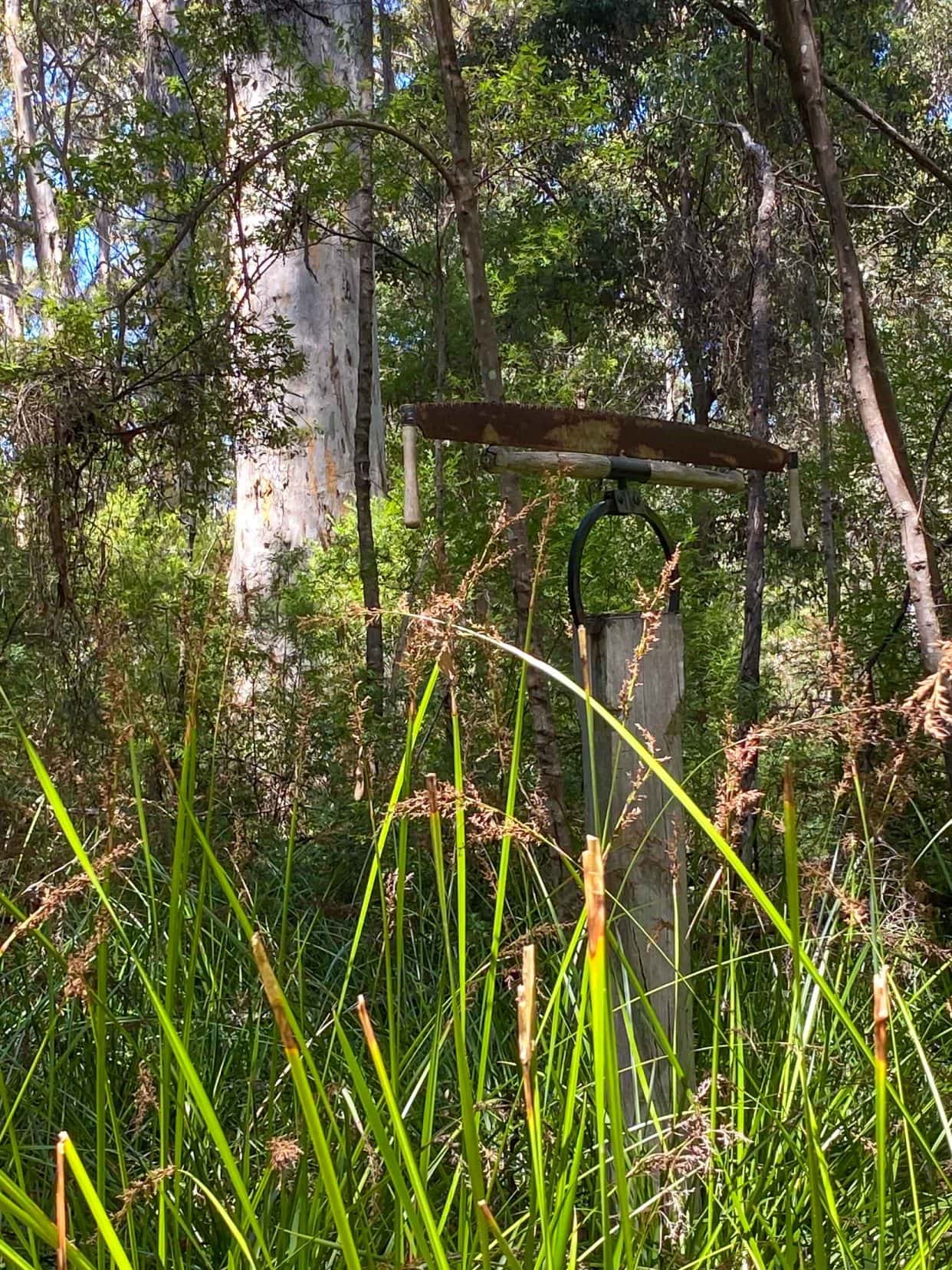
These tools represent human endeavour and courage in the colonising of Western Australia.
The Colonial Totem is an historical window of attached meanings.”
– Lorenna Grant & Alan Clark

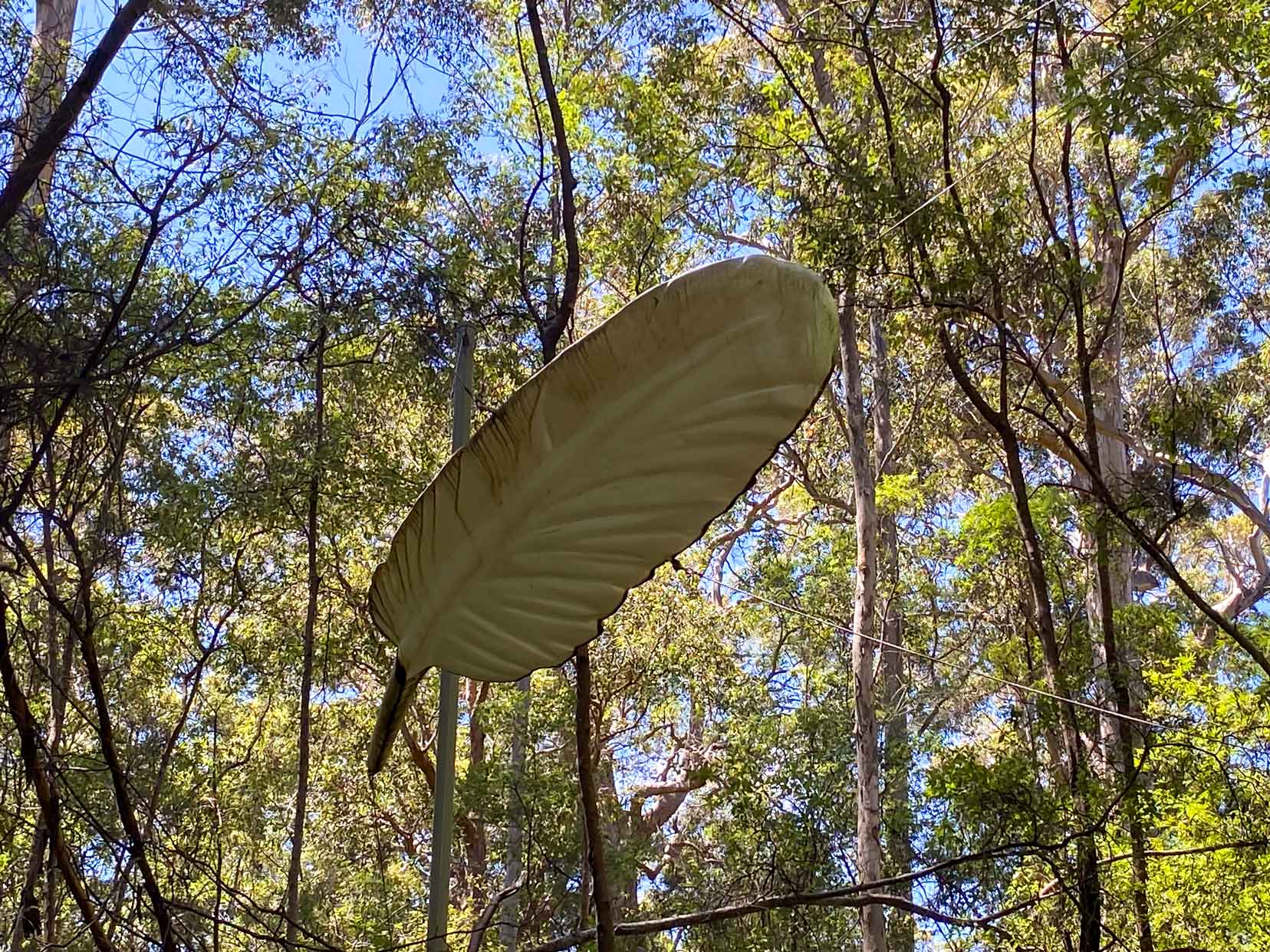
The Swarbrick Art Loop is a testament to humanity’s evolving ideals and necessities—a living chronicle of our relationship with the earth and a mirror reflecting our role in its future.
Why is it Called Swarbrick Art Loop?
Here, I explain what the Swarbrick Art Loop symbolises and why it bears the name Swarbrick.
This trail is a homage to the relentless efforts of environmental activists who fought to preserve the Swarbrick forest block.
At the turn of the millennium, the region was at a crossroads, with community opinions on protecting the forests divided.
Campaigners spent years trying to stop the logging of the Swarbrick Forest Block – camping out in the cold and rain during winter months and doing everything they could to protect the land.
Unfortunately, they lost most of the forest, but the outcome did have a silver lining. The Walpole Wilderness was developed and set aside as a protected environment.
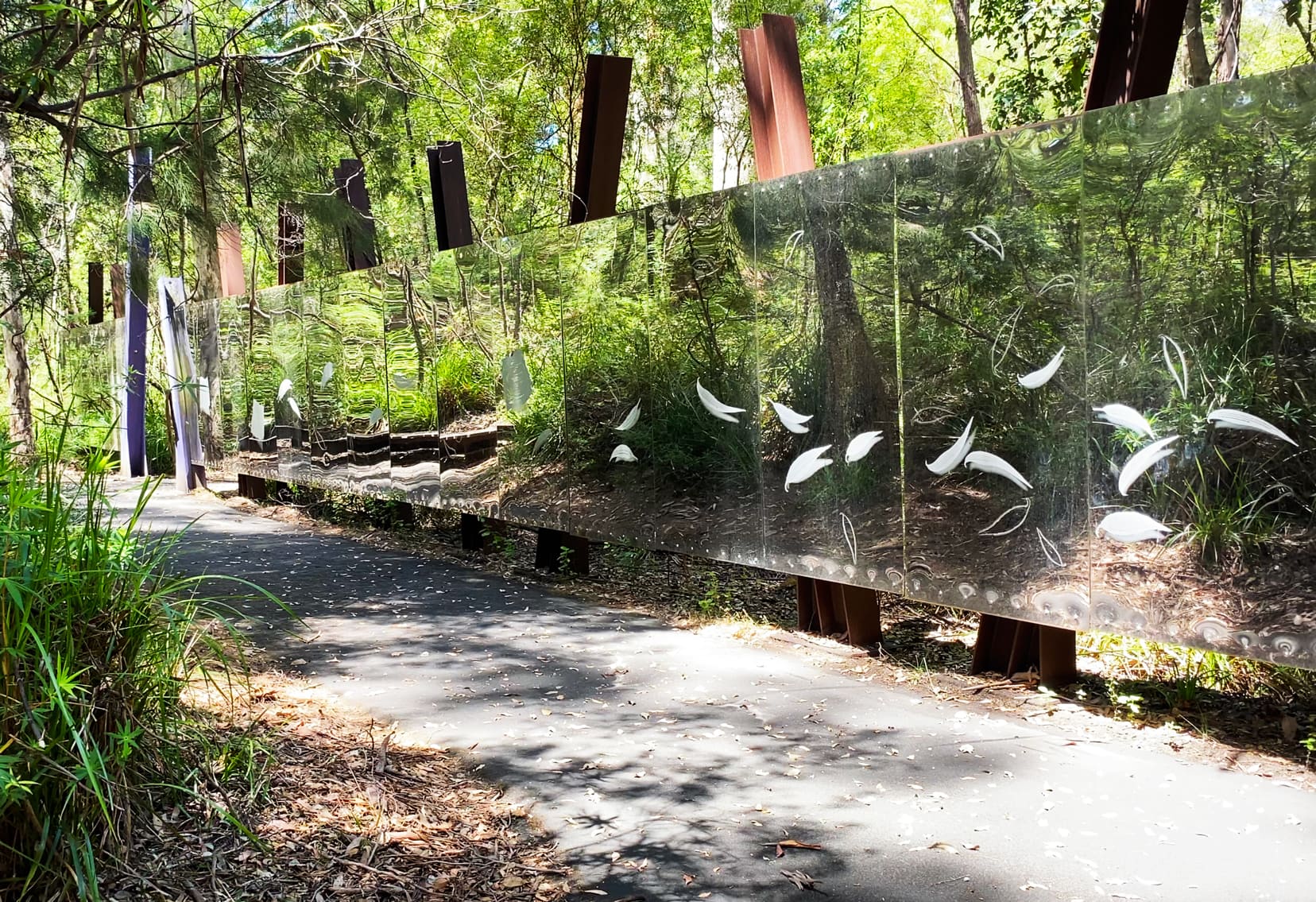
Jess Beckerling, an instrumental voice in the campaign, remarks on the sea change in local attitudes now:
“These days, Walpole really celebrates the forests… The Walpole Wilderness Area is a massive drawcard for tourists to this area. And the Walpole community is really behind the National Park and those wilderness areas.”
Jess Beckerling (quoted in Heartland Journeys)
For a closer look at the conservation story, Jess Beckerling’s insights in this video shed light on the pivotal moments and the community’s journey towards embracing the cause of environmental protection.
Honouring Historical Roots
But why was it called the Swarbrick Forest Block?
Tom Swarbrick, born in 1888 in Albany, settled in Walpole at Rest Point, and his endeavours were instrumental in shaping the community.
He built a sawmill, the iconic Swarbrick jetty, an eight-bedroomed guest house and piloted boat trips along the Walpole and Nornalup Inlets.
In fact, the spirit of Tom Swarbrick’s legacy sails on with the WOW Wilderness eco-cruises, which echo his early voyages, inviting visitors to experience the beauty and serenity of the inlets while fostering an appreciation for the region’s natural wonders.
This Forest Block was named after Tom Swarbrick in 1964.
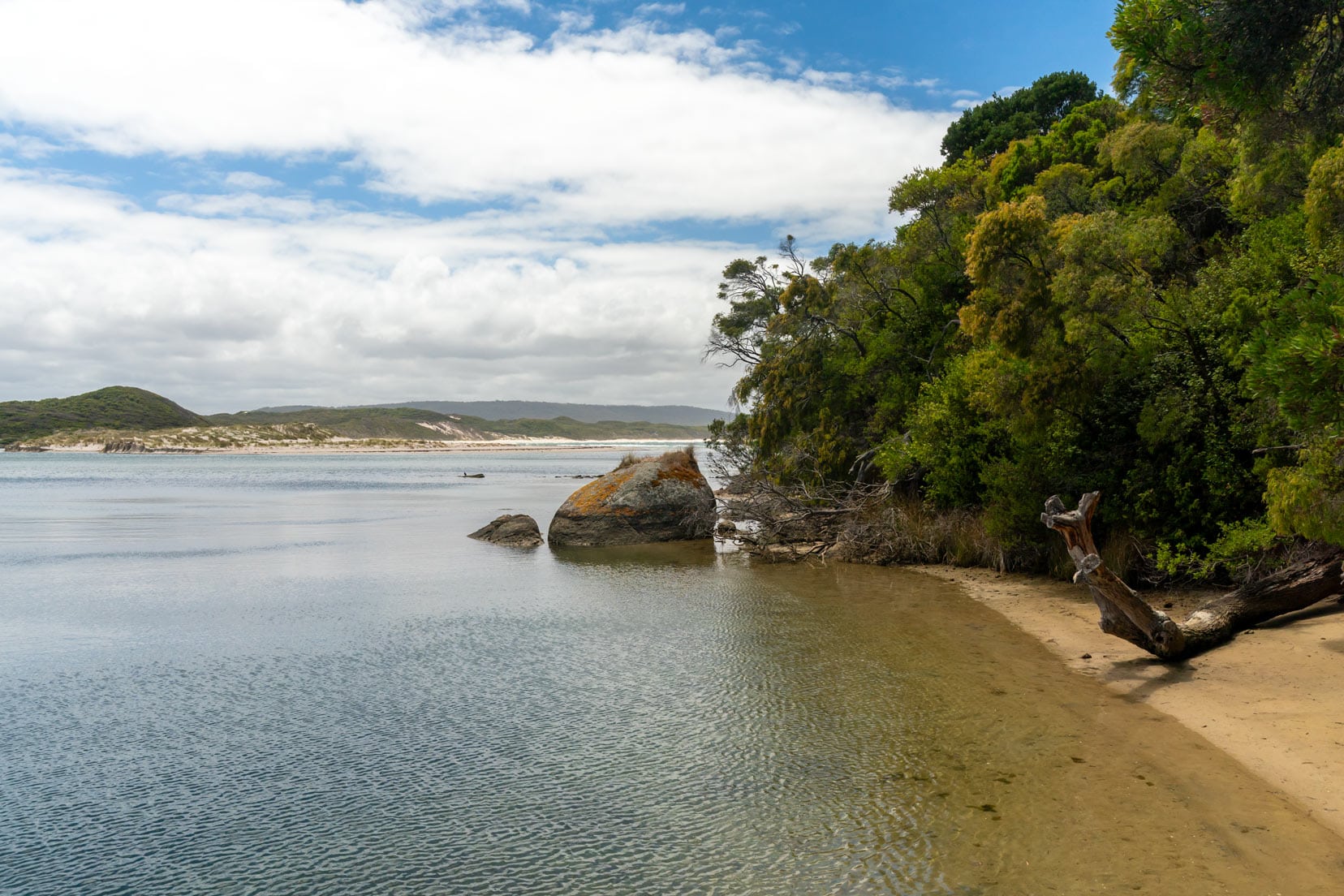
The Swarbrick Forest Block: A Conservation Milestone
Today, the Swarbrick Art Loop showcases nature’s resilience and is a testament to the community’s shift towards sustainable forestry and conservation.
The transformation from a site of intense logging to one of protection and natural beauty mirrors the broader changes in Western Australia’s environmental policies.
In January 2024, native tree logging was banned in Western Australia. WA’s Forestry Minister, Jackie Jarvis, noted the significance of the ban on native logging:
“We couldn’t keep logging the forest in the way we were when those trees just don’t regenerate. These are beautiful, 100-year-old trees, and we just cannot keep chopping them down at the rate we were.”
This statement underscores the state’s decisive action to protect around 2 million hectares of forest, aiming to restore the wilderness to its condition before European settlement and contribute to the region’s resilience against climate change (ABC News).
The Swarbrick Art Loop reminds us of our environmental responsibility and is a tribute to those who have contributed to preserving this precious landscape.
It stands as a living history lesson, inviting us to step into the narrative of a community that has come full circle—from supporting the timber industry to championing the cause of conservation.
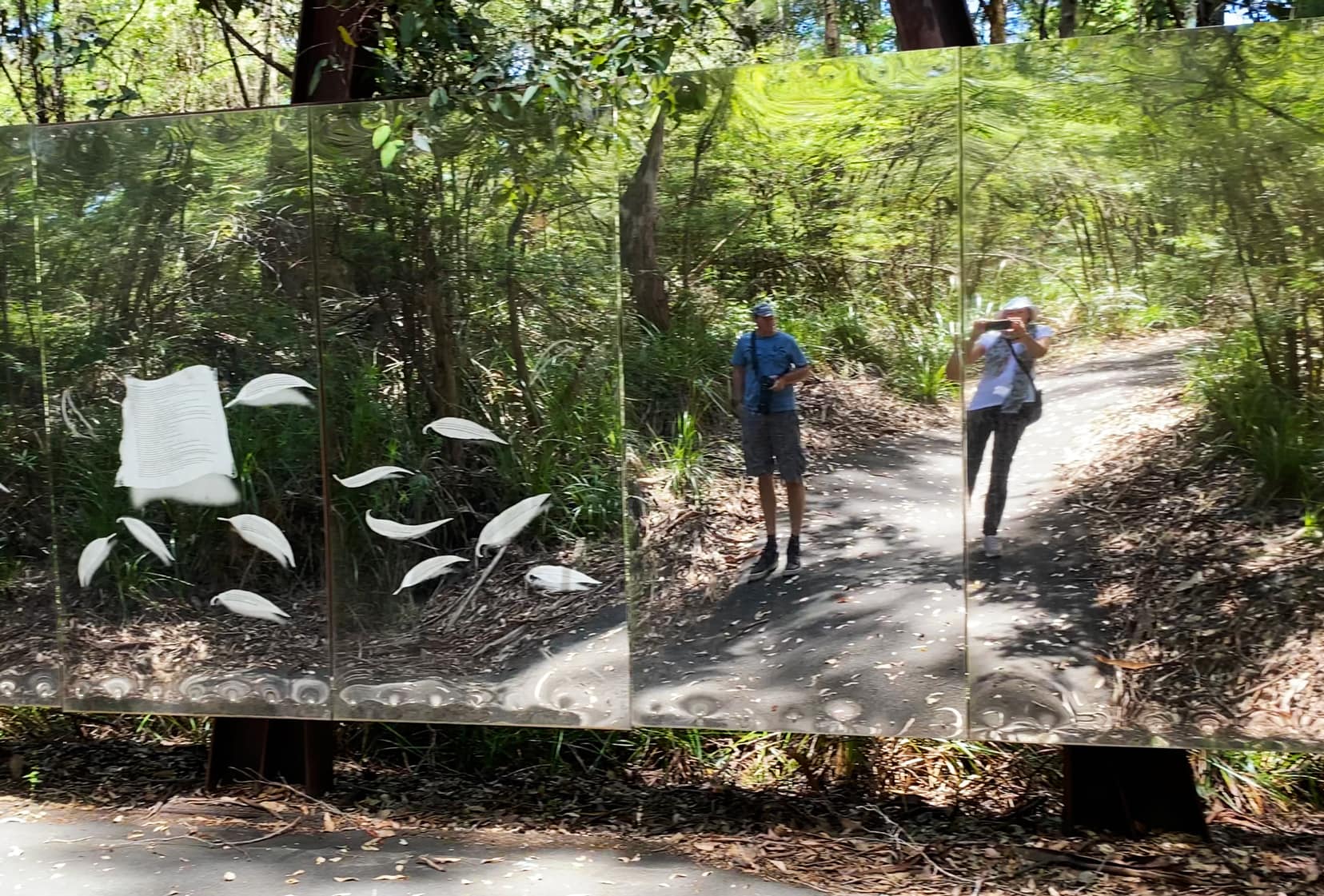
Beyond the Loop
Extend your Swarbrick Art Loop adventure with these other attractions in and around Walpole, each offering a unique slice of the region’s natural and cultural beauty:
- WOW EcoCruise Walpole: Embark on the Walpole WOW EcoCruise for an enlightening journey through stunning inlets. Explore the WOW EcoCruise in detail.
- Coalmine Beach Heritage Trail: Discover serene walks just 2km away on the Coalmine Beach Heritage Trail in Walpole. Uncover the Coalmine Beach Heritage Trail secrets.
- Knoll Scenic Drive: Enjoy breathtaking views a short drive from town on the Knoll Scenic Drive in Walpole. Experience the Knoll Scenic Drive.
- Giant Tingle Tree: Witness ancient eucalypts 10km from Walpole at the Giant Tingle Tree.
- Circular Pool: Find tranquillity at Circular Pool, a natural wonder 15km away.
- Valley of the Giants Tree Top Walk: Walk among towering tingle trees 18km west of Walpole on the Valley of the Giants Tree Top Walk.
- Conspicuous Cliff: Marvel at the Conspicuous Cliff and beach with spectacular ocean views 20 km southeast of Walpole.
- Greens Pool: Dive into the crystal-clear waters of Greens Pool in Denmark, about 65km east of Walpole.
- Denmark: Explore the charming town of Denmark, WA, known for its wineries and beaches, roughly 70km east of Walpole.
- Pemberton: Venture into Pemberton’s towering karri forests for scenic drives, approximately 120km southwest of Walpole and explore its huge inland dune system at Yeagarup Dunes.
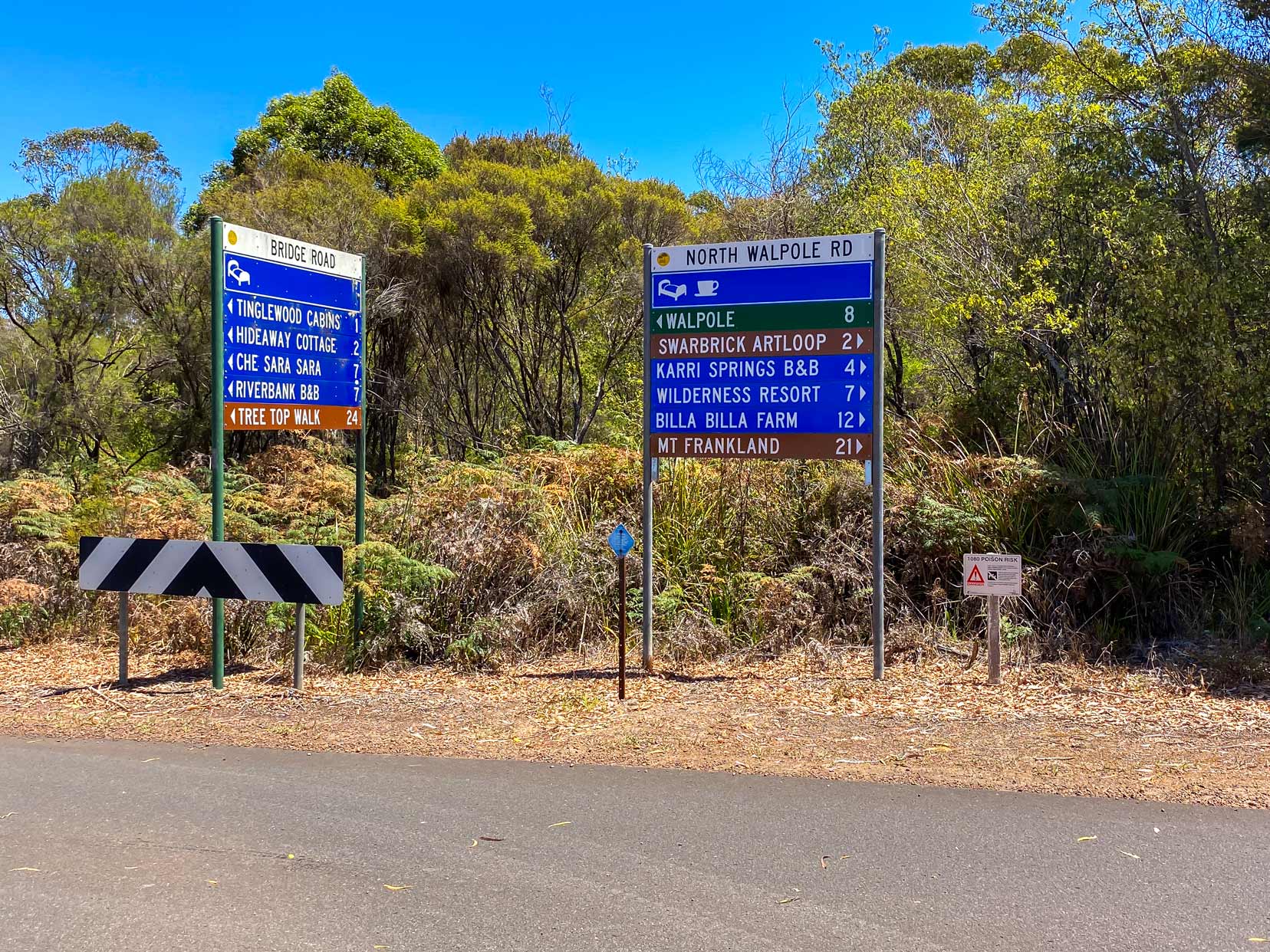
Swarbrick Art Loop: A Journey of Understanding
As we depart from the Swarbrick Art Loop, we carry the echoes of those who have passed before us and the knowledge that our actions today write the stories of tomorrow.
This is not just a walk through the woods but through time and conscience.
We leave with a renewed commitment to our planet, inspired by the art that so delicately frames the story of this land and its people.
Ready to see the forest in a new light?
Visit the Swarbrick Art Loop and join the conservation, reflection, and change narrative.
Next: Read our guide on the best things to do in Walpole and its surrounding area.
Pin on Pinterest for Later
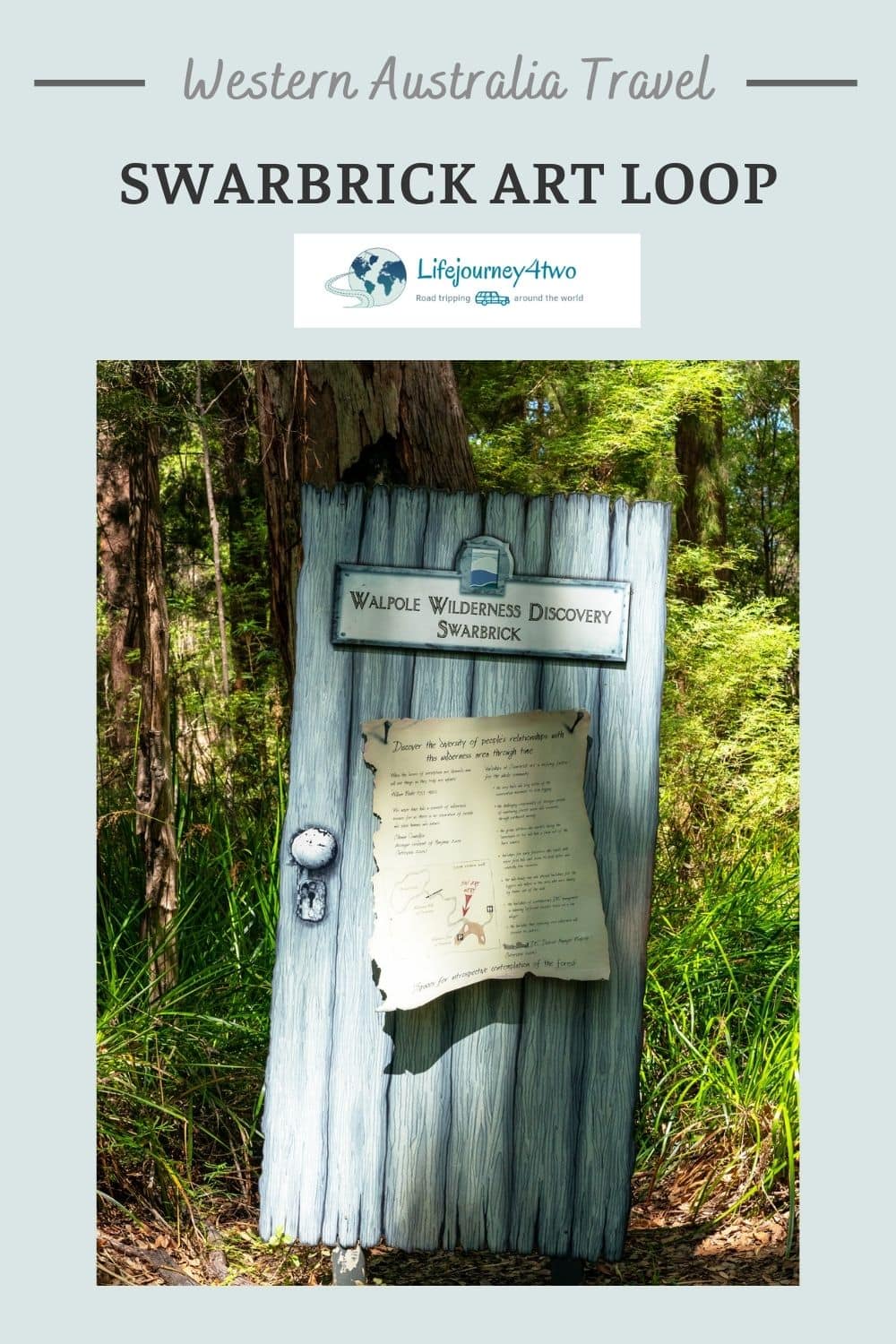
Honouring the Land’s Legacy
We recognise the Menang people as the traditional owners of the land where Mount Frankland South National Park stands today. Their connection to the land is a poignant reminder of the enduring relationship between people and this ancient forest.
PLANNING YOUR TRAVELS?
These are the travel resources we recommend and use when planning our trips.
- 🚘 Car Hire: We use DiscoverCars.com
- Motorhome/Campervan Rental: We highly recommend the Motorhome Republic
- 🛏 Book Accommodation: We use Booking.com to find accommodation that suits our budget
- 🐶 Pet Sitting/Pet Sitters: Check Out TrustedHousesitters here (Use our Discount code: LIFEJOURNEY25 for 25% off. )
- Activities and Experiences: Get Your Guide and Viator
- Travel Insurance: Safetywing or World Nomads
- 🥾 Travel Gear and Accessories: Check out our top picks here — Lifejourney4two page on Amazon
For a more thorough list visit our Travel Resources page here.

